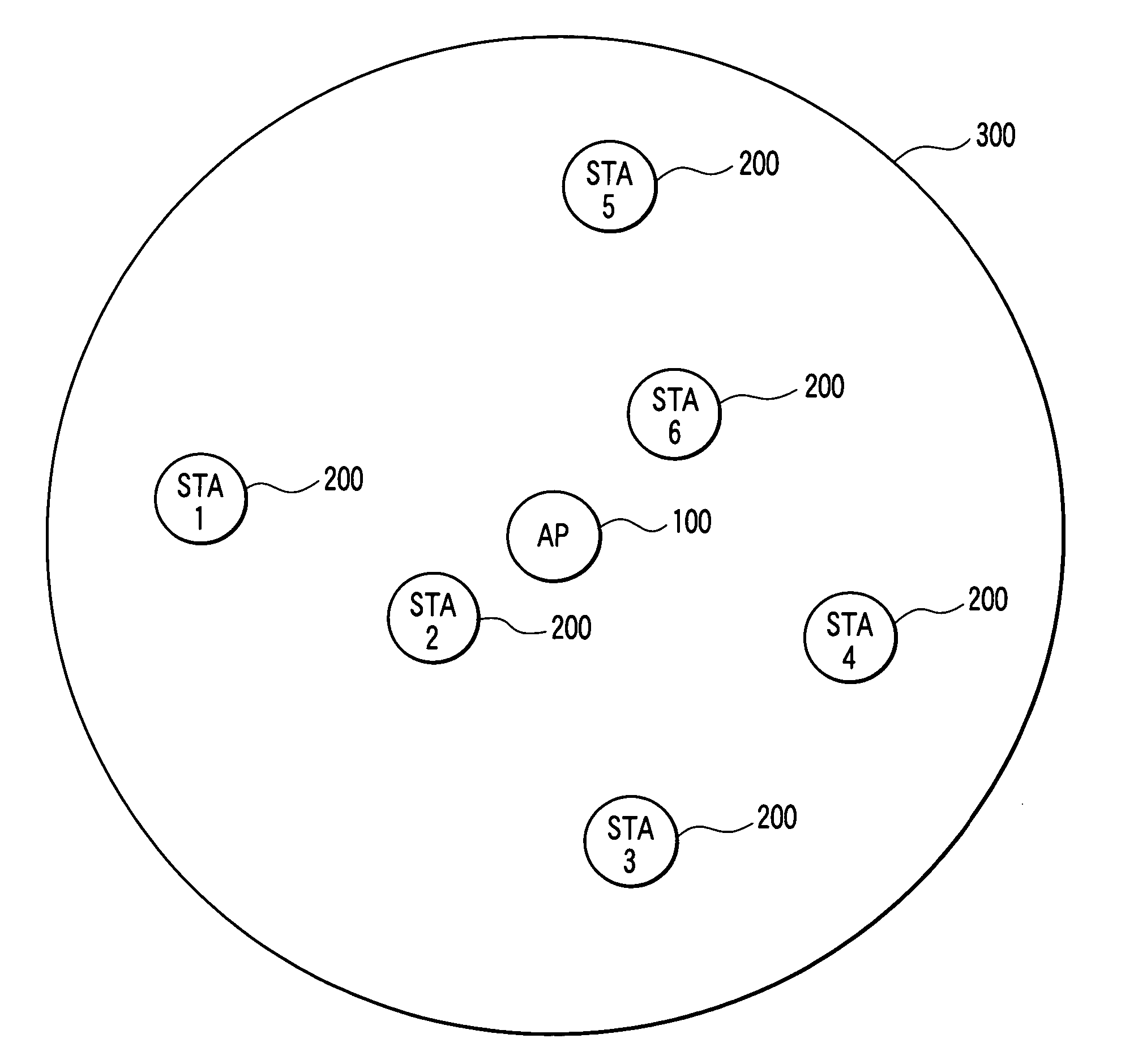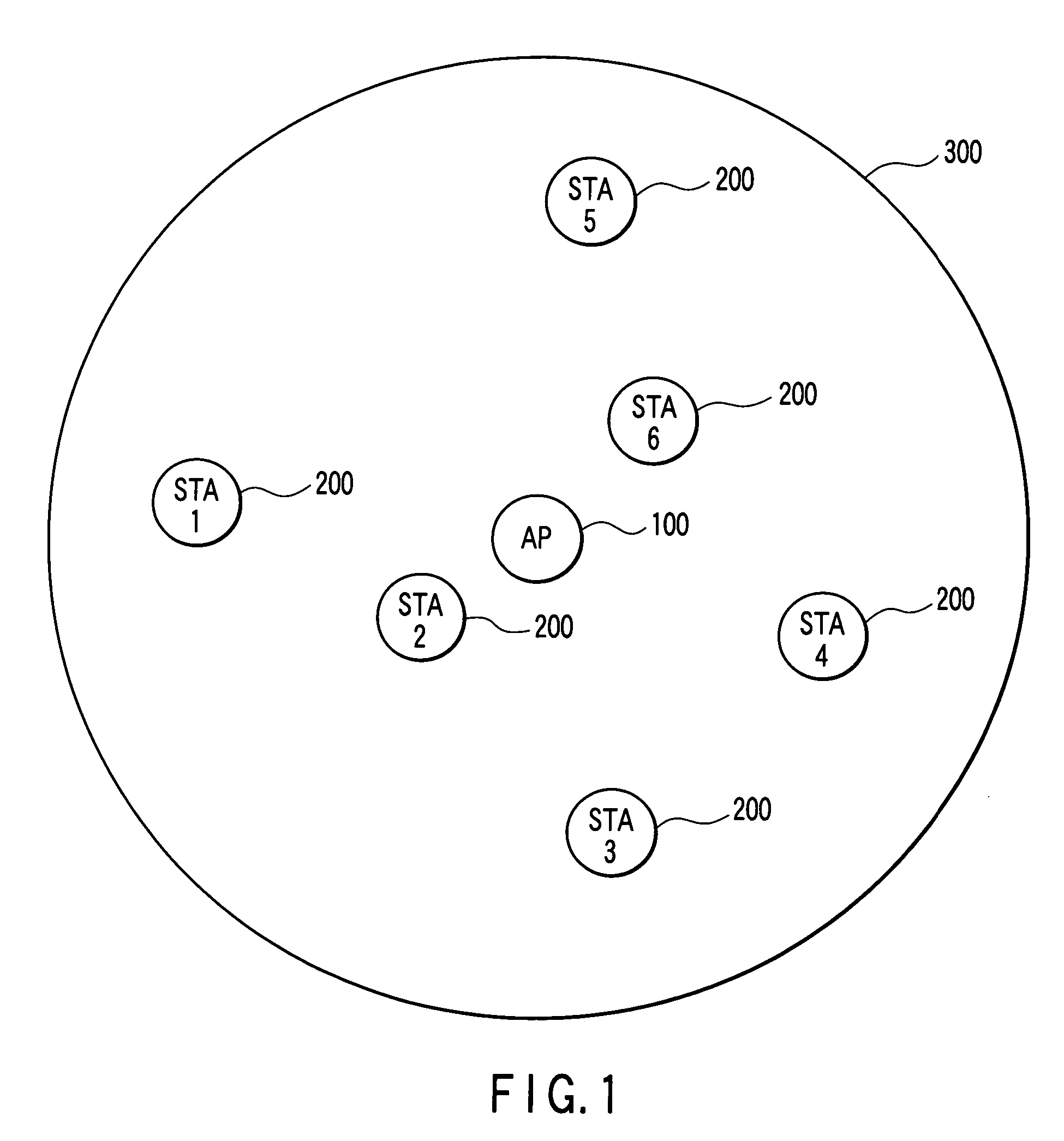Radio communication system
- Summary
- Abstract
- Description
- Claims
- Application Information
AI Technical Summary
Problems solved by technology
Method used
Image
Examples
first embodiment
[0035] Hereinafter, a first embodiment of the present invention will be described.
[0036]FIG. 1 shows the configuration example of the terminal arrangement in the radio communication system where the radio communication apparatuses (AP and STA) regarding the present invention are arranged.
[0037] In FIG. 1 the communication system includes an AP 100 and STAs 200. FIG. 1 shows a specific example in the case of a communication form by which six sets of STAs STA1-STA6 are connected wirelessly with one another in a radio cell [hereinafter referred to as basic service set (BSS)]300 to be managed by the AP 100.
[0038] In IEEE 802.11, a configuration unit of a BSS composed of one AP and more than one STA belonging to the AP is referred to as a BSS. In the first embodiment, the BSS 300 to be managed by the AP 100 will be described as an example; however the present invention will be possible to be adopted even to the case, instead of the configuration shown in FIG. 1, of a configuration of ...
second embodiment
[0101] Hereinafter, the second embodiment will be described.
[0102] Relationships between the priorities (TID) and the traffic stream (TS) will be described, at first.
[0103] The IEEE 802.11 can give the TID to data to be transmitted. The TID is expressed in figures like TID=0 to 15 and the data with a high TID will be obtained along with the increase of the figures. The data with a lower TID of TID=0 to 7 is transmitted in the EDCA method being a competitive method and the data with a higher TID of TID=8 to 15 is transmitted in the HCCA method being an uncompetitive method.
[0104] The HCCA method needs to set the TS to transmit / receive the data with TID=8 to 5.
[0105] The STA 200 desiring to transmit / receive the data of TID=8 to 15 prepares the TSPEC with a desired TID, a desired transmission direction (for Down link to receive from AP, for Up link to transmit to AP, for Bi-directional link to bi-directional transmit / receive to / form AP or inter-terminal communication direct link), ...
third embodiment
[0160] Hereinafter, the different point between the third embodiment and the second embodiment will be described mainly.
[0161] The point different from the second embodiment is a method for determining the ratio ξ of the ‘Bidirectional ratio’ of the EDCA Parameter sets. In the second embodiment, having calculated the ratio ξ of the ‘Bidirectional ratio’s of the EDCA Parameter sets on the basis of the number of the TSs established for each transmission direction, the third embodiment calculates it depending on the sum of the required throughput (Mean Data Rate) of the TSs which have been set for each transmission direction.
[0162] A configuration example of the AP 100 in the third embodiment may be the same as that of the second embodiment shown in FIG. 11. A configuration example of the STA 200 in the third embodiment may be the same as that of the second embodiment shown in FIG. 12. The third embodiment will be described by using the EDCA Parameter sets shown in FIG. 10.
[0163] In...
PUM
 Login to View More
Login to View More Abstract
Description
Claims
Application Information
 Login to View More
Login to View More - R&D
- Intellectual Property
- Life Sciences
- Materials
- Tech Scout
- Unparalleled Data Quality
- Higher Quality Content
- 60% Fewer Hallucinations
Browse by: Latest US Patents, China's latest patents, Technical Efficacy Thesaurus, Application Domain, Technology Topic, Popular Technical Reports.
© 2025 PatSnap. All rights reserved.Legal|Privacy policy|Modern Slavery Act Transparency Statement|Sitemap|About US| Contact US: help@patsnap.com



